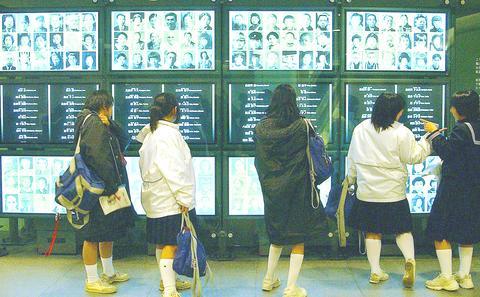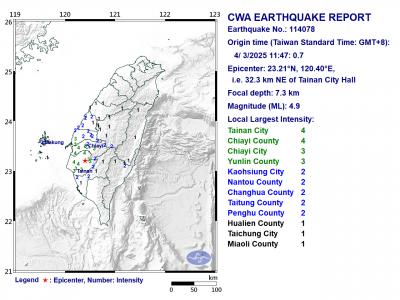Near where the atomic bomb detonated over Hiroshima, the faces of the victims silently appear and fade on a wall of television monitors in a relentless display of the attack's terrifying human toll.
Amid the thousands of faces, one stands apart: that of Corporal John Long, US Army Air Force.
Long, who died in the blast while being held by the Japanese, last month became the first US serviceman to be enshrined at a memorial here, throwing light on the little-known story of US prisoners of war who perished at Hiroshima.

PHOTO: AP
"It shows how indiscriminate the slaughter was," said Shigeru Aratani, a curator at the Hiroshima National Peace Memorial Hall for the Atomic Bomb Victims. "Enemies and friends, soldiers and civilians, women and children -- they were all killed."
Long bailed out of his B-24 bomber as it was shot down near Hiroshima days before the Aug. 6, 1945 bombing.
The 27-year-old steelworker from New Castle, Pennsylvania, was among at least 10 American prisoners of war (POWs) killed in the attack.
The flier's picture provides one of the few hints at Hiroshima's Peace Park of a tale that was unpublicized for decades.
The names of seven US POWs have been added since the 1970s to an official book of victims updated annually by the city, but the list is encased in a stone cenotaph and is not visible to the public.
The US prisoners were absent from the memorial hall, which opened in 2002 and displays photographs of 9,000 bomb victims for 700 visitors a day, until Long's 35-year-old great nephew, Nathan Long, offered the airman's photo last month.
Long says the portrait is a "small story" compared to the catastrophic suffering of Japanese victims. But he said it has big implications for the way Americans remember the bomb.
"I think most Americans would look at all those Japanese faces and say, `That's too bad. A lot of Japanese people died.' But you get one American face and they might feel a little more of a connection," said Long, who grew up in Japan and works in Tokyo as a teacher.
The bombing killed some 140,000 people. Thousands of Koreans brought to Japan as forced labor died, as did Americans of Japanese descent who were trapped after war broke out.
But the POWs are among the least remembered casualties -- their fate wasn't widely known until researchers digging through archives began to document the story in the 1970s.
An important clue came in 1977 when a professor from Hiroshima University found a Japanese list of 20 American POWs listed as killed in the atomic attack.
Some of those names were later found to belong to prisoners who had been killed elsewhere in grisly experiments that the Japanese military apparently wanted to hide.
The others were the crews of three aircraft -- two B-24 bombers, including Long's, and a Helldiver dive bomber -- shot down near Hiroshima on July 28, 1945 after a raid on Japanese warships in nearby Kure.
One of the first US scholars to investigate, Stanford University professor Barton Bernstein, said the US military claimed a fire had destroyed personnel files needed to verify the matter.
But records obtained by resear-chers through the Freedom of Information Act in the 1980s confirmed at least 10 US airmen were listed killed in the blast, Bernstein said.
"We had difficulty prying it out of the Pentagon," he said, adding he suspects the US casualties were not made public after the war to "block any moral doubts" about dropping the bomb.
Thomas Cartwright, the pilot of Long's bomber, said the families of some of the POWs struggled to learn details of their deaths from military authorities who were slow to act on information he provided.
Cartwright, now 80, was saved when he was transferred from Hiroshima to Tokyo for interrogation five days before the atomic blast.
"I think the military would like this to fade away," he said from his home in Moab, Utah.
Cartwright, who has written a book about his experiences titled A Date with the Lonesome Lady: A Hiroshima POW Returns, remembers Long as the "coffee drinker of the crew" -- a likable but serious gunner who spent his money on tools instead of liquor.
Long's sparsely captioned picture at the Hiroshima memorial -- which lists just his name and occupation -- tells visitors very little. But for some his face says everything.
"I wonder if there was any consideration given to them before the attack," said visitor Alice Carol Caldwell, 64, of Starkville, Mississippi, whose eyes welled with tears as she looked at Long's face.
Japanese boys listened quietly as a curator told Long's story.
"He was fighting for his country," said Keiichi Hatanaka, 14. "I'm sure he never imagined he would be killed by his friends."

A magnitude 4.9 earthquake struck off Tainan at 11:47am today, the Central Weather Administration (CWA) said. The hypocenter was 32.3km northeast of Tainan City Hall at a depth of 7.3km, CWA data showed. The intensity of the quake, which gauges the actual effect of a seismic event, measured 4 in Tainan and Chiayi County on Taiwan's seven-tier intensity scale, the data showed. The quake had an intensity of 3 in Chiayi City and County, and Yunlin County, while it was measured as 2 in Kaohsiung, Nantou County, Changhua County, Taitung County and offshore Penghu County, the data showed. There were no immediate reports of

‘DENIAL DEFENSE’: The US would increase its military presence with uncrewed ships, and submarines, while boosting defense in the Indo-Pacific, a Pete Hegseth memo said The US is reorienting its military strategy to focus primarily on deterring a potential Chinese invasion of Taiwan, a memo signed by US Secretary of Defense Pete Hegseth showed. The memo also called on Taiwan to increase its defense spending. The document, known as the “Interim National Defense Strategic Guidance,” was distributed this month and detailed the national defense plans of US President Donald Trump’s administration, an article in the Washington Post said on Saturday. It outlines how the US can prepare for a potential war with China and defend itself from threats in the “near abroad,” including Greenland and the Panama

The Chinese Nationalist Party (KMT) is maintaining close ties with Beijing, the Democratic Progressive Party (DPP) said yesterday, hours after a new round of Chinese military drills in the Taiwan Strait began. Political parties in a democracy have a responsibility to be loyal to the nation and defend its sovereignty, DPP spokesman Justin Wu (吳崢) told a news conference in Taipei. His comments came hours after Beijing announced via Chinese state media that the Chinese People’s Liberation Army’s Eastern Theater Command was holding large-scale drills simulating a multi-pronged attack on Taiwan. Contrary to the KMT’s claims that it is staunchly anti-communist, KMT Deputy

RESPONSE: The government would investigate incidents of Taiwanese entertainers in China promoting CCP propaganda online in contravention of the law, the source said Taiwanese entertainers living in China who are found to have contravened cross-strait regulations or collaborated with the Chinese Communist Party (CCP) could be subject to fines, a source said on Sunday. Several Taiwanese entertainers have posted on the social media platform Sina Weibo saying that Taiwan “must be returned” to China, and sharing news articles from Chinese state media. In response, the Mainland Affairs Council (MAC) has asked the Ministry of Culture to investigate whether the entertainers had contravened any laws, and asked for them to be questioned upon their return to Taiwan, an official familiar with the matter said. To curb repeated